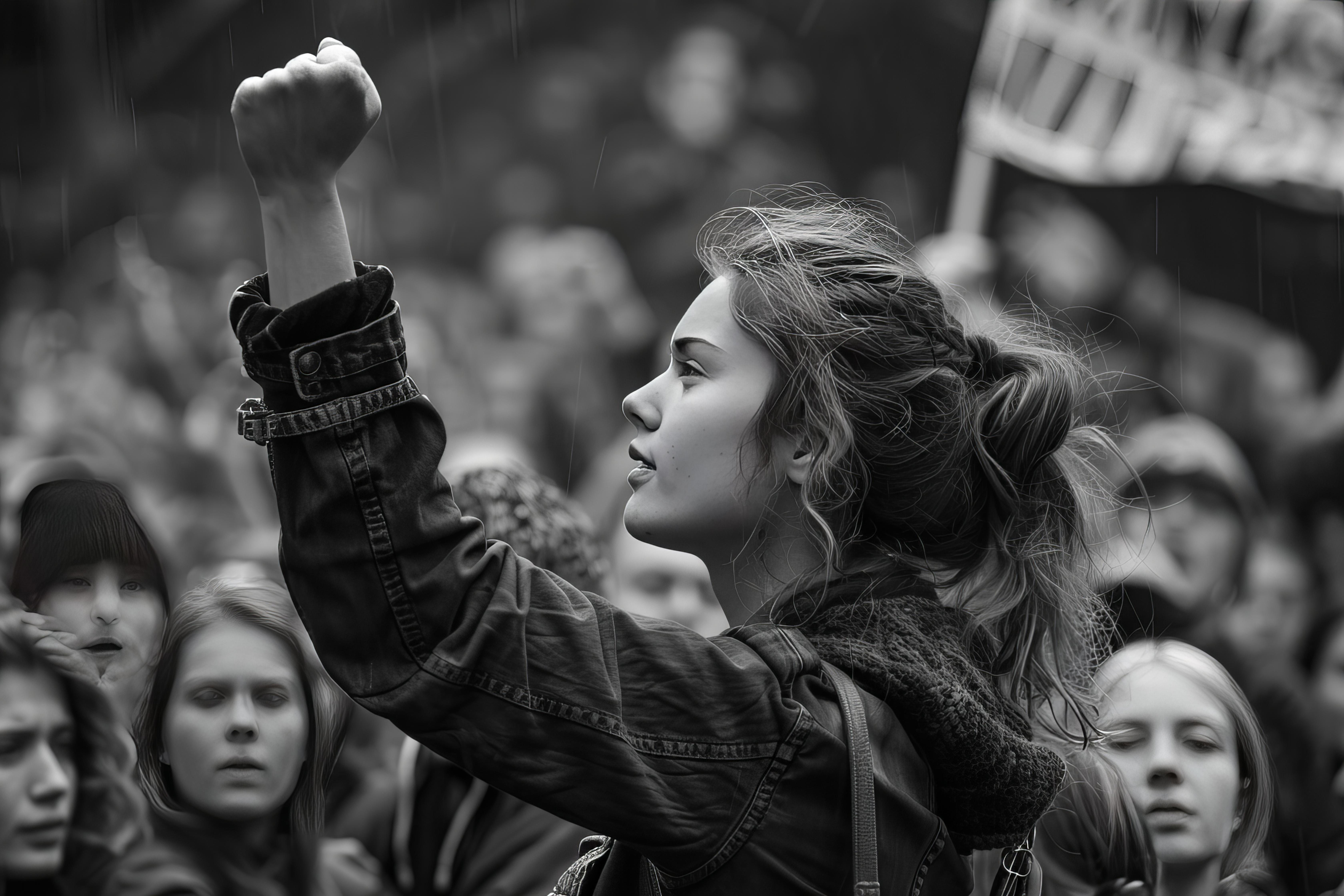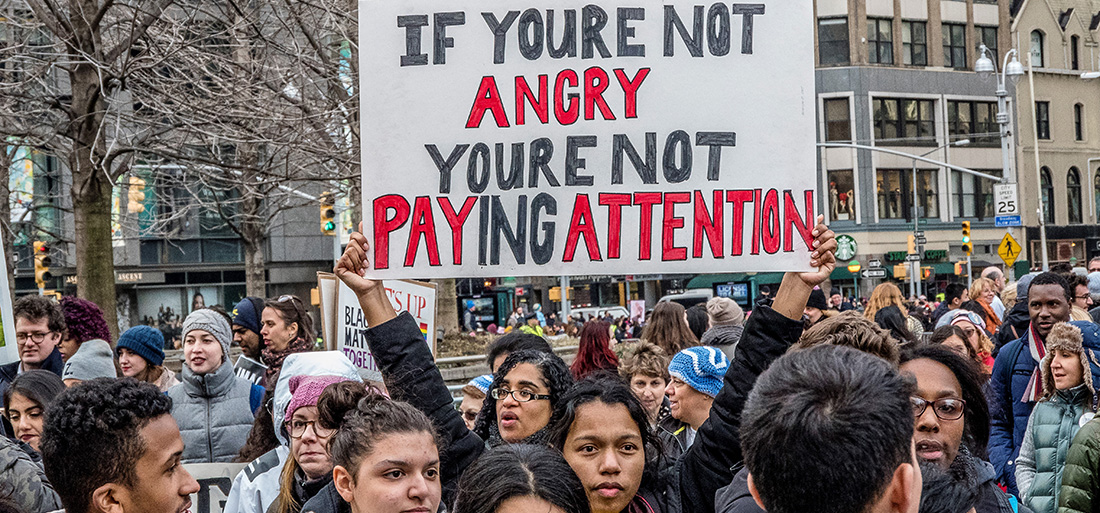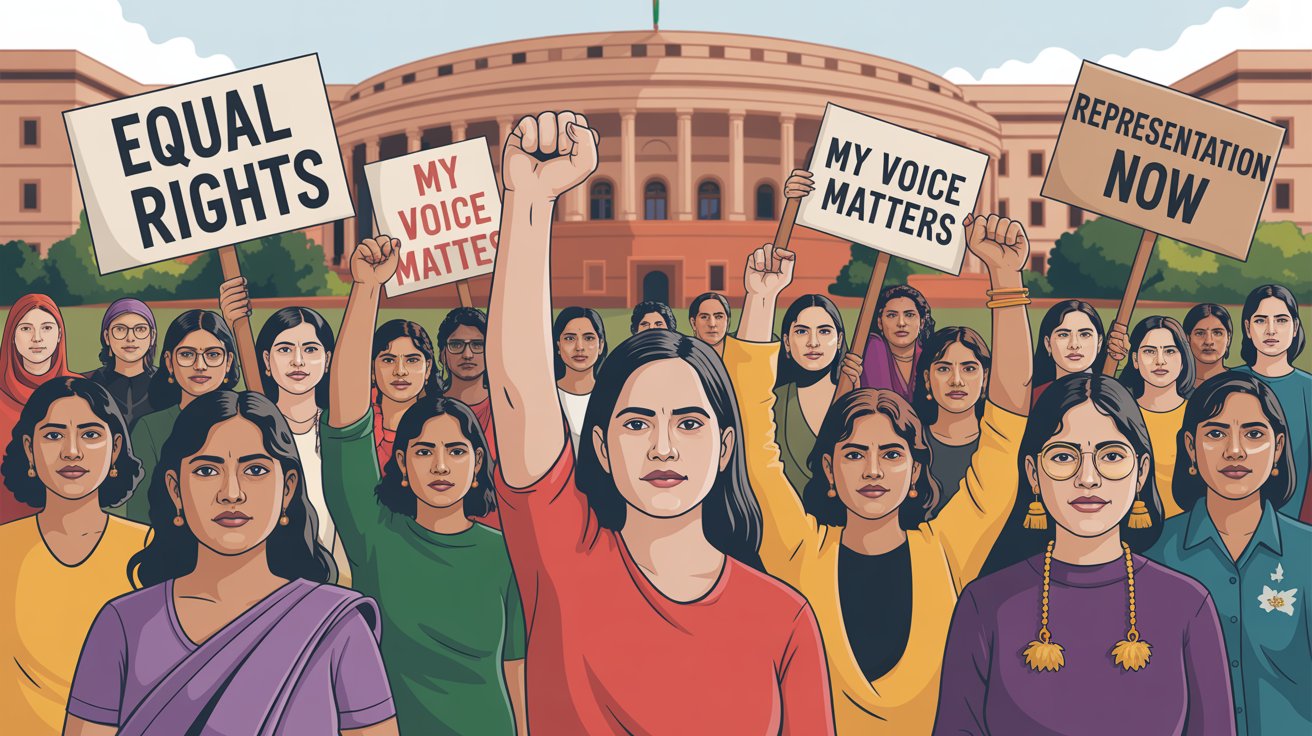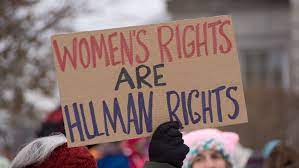Political Feminism in India and Asia

Dr. Vibhuti Patel is a feminist scholar and activist who has been part of social movements in India and the Global South since the 1970s. In this article, she traces the evolution of political feminism in India and Asia over the last five decades, highlighting its local struggles, global solidarities, and current crossroads. She reflects on how feminist movements have challenged patriarchal systems and shaped transformative policy and grassroots action.
Political feminism is marked by achieving gender equality through political action and systemic and structural changes to dismantle patriarchal values and attitudes perpetuating gendered power relations. A political feminist perspective considers the political sphere as a key arena for addressing the disadvantaged women, children and gender minorities. Political feminists advocate for policies and laws that promote the rights of women, queer persons' rights and communities that face intersectional vulnerabilities of caste, class, race, ethnicity, disability and gender by challenging existing power structures, and working towards a more just and equitable society for all genders. Over the last 50 years (1975-2025), the Political feminism in India and Asia has encompassed diverse movements with rights-based approaches advocating for gender justice, economic justice, social justice, environmental justice and distributive justice within complex socio-cultural, political, and economic contexts. These movements of involving youth, women, LGBTQIA+ groups, farmers, ethnic minorities, urban and rural poor migrant workers, grapple with issues ranging from legal reforms in criminal and civil laws, social policies, access to education and healthcare, gender equality at workplace and gender based violence (sexual violence, trafficking of women and children, acid attacks, domestic violence, forced marriages, sexual harassment at workplace, crimes in the name of honour, reproductive control, atrocities against Dalits, Adivasis and religious minorities ) to representation of gender concerns in media and the impact of globalization and technology. Feminists are commemorating 3 decades of the Beijing+30 conference and debating the 12-point Action Agenda adopted by global feminists in 1995. Feminist activism in the region is characterised by both incremental successes in challenging patriarchal structures and persistent struggles against backlash and entrenched inequalities. Feminist movements in India and Asia are not monolithic, have had diverse approaches and have influenced a wide range of groups, political parties, NGOs, and individual activists with diverse perspectives and priorities (Chaudhuri, Maitreyee and Rajeshwari Sunder Rajan, 2004).
Political Feminism in India:

Political feminist leadership and its Strategies in India got crystallised in the late 1970s. The genesis of the new women's liberation movement lay in the radicalisation of Indian politics in the late sixties. Rebellious mood of the youth, poor peasants, marginal farmers, educated Dalit and tribal men and women, industrial working classes found its expression in the formation of innumerable special interest groups addressing themselves to the needs and demands of the local masses. Macro political processes were also finding major shifts in their rhetoric as the protest movements of the subaltern masses had taken militant paths guided by different political ideologies. The official communist parties faced major political challenges in the form of the Naxalbari movement in Kerala, West Bengal, Andhra Pradesh, Bihar and Punjab. Middle-class mass upheaval in Gujarat (popularly known as Navnirman movement) against corruption, price rise, unemployment, speculation, hoarding and black-marketing in 1974 was replicated in Bihar in the name of Sampoorna Kranti Movement under the leadership of a Gandhian leader, Jay Prakash Narayan. The unprecedented strike of the railway workers gave proof of the political power of the collective strength of the working class. Tribal people's struggles against destructive development, which served the interests of the kulaks, moneylenders, contractors, bootleggers and indigenous industrialists thriving on the barbaric means of surplus extraction developed in Chhattisgarh, Singhbhoom, Bhojpur, Srikatulam, Chandrapur, Dhulia and in the pockets of the North Eastern states. In response to the 1974 drought paralysing normal agricultural activities, the tribal masses in the Dhule region of Maharashtra demanded the Employment Guarantee Scheme. This historic demand has revolutionised the thinking of the development workers about the responsibility of the state during the time of economic crisis. (Patel, 1910)
In the Himalayan valleys, under the leadership of Gandhian community workers, the struggle against the arbitrary felling of trees, which led to deforestation and massive scarcity of fuel, fodder, water and seasonal fruits, and landslides devastating villages after villages began. Women evolved a creative method to protect the trees from the axes of contractors' henchmen. This movement was popularly known as Chipko because women hugged the trees when their adversaries made ferocious efforts to fell the trees.
In Maharashtra, women activists and women intellectuals involved in progressive movements took initiative in forming a united front called the Anti-Price Rise Women's Committee and organised direct action against the culprits who created man-made scarcity of essential goods. Thousands of poor and lower-middle-class women joined the struggle under the leadership of seasoned and able women from the left and socialist background. Mrinal Gore, Ahalya Ranganekar, Manju Gandhi and Tara Reddy made their special mark in the eyes of the masses because of their unique ability to reach out to the women of different class backgrounds. Their intellectual self-sufficiency, ability to relate micro issues to macro political reality, simple lifestyle and non-bossy nature provided role models to the younger generation of women's liberation activists of all political hues. Around the same time, a conference of the Women's Liberation Movement Coordination Committee (Stree Mukti Andolan Sampark Samiti) was organised in Pune. This had an even larger socio-political and cultural base as right from young educated women, professionals, writers, teachers, industrial working-class women, unorganised sector women workers, temple prostitutes, and tribal women participated in the deliberations and highlighted their demands.
Stree Mukti Sangathana in Bombay and Progressive Organisation of Women in Hyderabad were formed in 1974. In Delhi, new leadership among women evolved from the radical students' movement and the democratic rights movement. Individual women in different political groupings all over India were feeling discontented about patriarchal biases in their organisations, but they came out openly against it only after the emergency rule ended. These were independent, self-determining and democratic movements, which questioned all hierarchical structures. In India, young people of that period had not participated in the dreams of the nationalist movement. Faced with multiple crises- economic, social and political, along with corruption, drought, inflation, unemployment, and pauperisation of the rural poor - the disenchanted youth responded with protest. Widespread, open discontent was expressed in action and the consolidation of the action developed into powerful organisations throughout the country. These movements raised a number of diverse issues-land rights, wages, employment, security at the workplace, water availability, destruction of nature, oppression and exploitation of the Dalits (the untouchables) and the working masses. Many women participated in these struggles with enthusiasm, responsibility and creativity (Patel, 2010).
The UN Declaration of 1975 as an International Women's Year coincided with the Emergency Rule in India. By the time the Emergency was lifted in 1977, several women's groups had developed around democratic rights issues. The press swung into "action" after the imposed silence of nearly two years. Atrocities committed against women during the Emergency were openly documented and reported in the press. These atrocities struck a chord in most women's own experience of life in the family, in the streets, in the workplace and in political groups. The culmination of this process was reached in 1980 when many women's groups took to the streets to protest. During the 1980s, the issue of women's oppression was depicted not only in discussion forums, seminars and `serious' articles but also in the popular media. Women, who had on their own identified the sources of their problems and indignity, began to acquire a language, an organisational platform, a collective identity and legitimacy they did not have earlier.
The Status of Women's Committee appointed by the GOI released a voluminous report called Towards Equality in 1974. This report was prepared by scholars with an interdisciplinary perspective and was presented in the Parliament of India, where it received a tremendous response from the decision-making bodies, the state apparatus and the print media. Shocking description of Indian women's reality, which manifested in declining sex ratio, very high rate of female mortality and morbidity, marginalisation of women in the economy and discriminatory personal laws were some of the major highlights of the report. But the report failed to throw any light on violence against women in the civil society and by the custodians of law and order. The major achievement of the report lay in the policy decision taken by the principal research body, like the Indian Council of Social Science Research (ICSSR), i.e. to provide financial support to scholars committed to the women's cause, to conduct research into problems faced by women in poverty groups.
Emergence of Autonomous Women’s Organisations in India

Between 1977 and 1979, new women's groups emerged in cities like Delhi, Bangalore, Hyderabad, Bombay, Ahmedabad, Patna, and Madras. They organised protest actions against dowry murders, beauty contests, sexist portrayal of women in media, pornographic films and literature imported from abroad, introduction of virginity tests by the U.K. immigration authorities, custodial rape and pitiable condition of women in prison. These groups were multicultural in their composition and worldview. As a result, their political agenda reflected the contemporaneous handling of the complex reality of women constructed by the interplay of class, caste, religion, ethnicity and globalisation. The spokesperson of these groups had the advantage of a high level of ideological investment and the experience of the radical movements of the late sixties. Their collective wisdom provided the main backbone to the movement. Their newsletters, magazines and booklets in regional languages as well as in English provided a creative way of handling Indian women's problems. The need to study women's issues in academic institutions and to conduct research based on experiential material and affirmative action was beginning to be discussed among Indian women's studies scholars by the early eighties. During the late 1990s, research on ‘caste, caste and gender’ got legitimacy due to the sustained academic engagement of Sharmila Rege (2006). The discourse on this subject has proved to be a fruitful exercise for activists, academics, researchers, policy planners and the UN system.
Methods of Functioning of the New Autonomous Women's Groups:
Most of the women who took initiative in the formation of the new women's groups were extremely averse to authoritarian structures within the family, educational and religious institutions and society at large, as all of them did not allow women critical thinking and a space to grow as independent, cerebral and politically conscious human beings. Hence, they were very clear in their approach that they would encourage each and every member of the group to articulate her thoughts and establish an intimate working relationship based on the collective decision-making processes. Initially this method proved very effective in creating new cadre of women who were intellectually enlightened, politically articulate, well informed and supportive to each other within their small groups as there were no male political bosses to curb their initiative and make them rot only in routine activities of fund-raising, translating, typing, posting, cleaning and cooking for the members of their political groups. Such groups in Madras, Bangalore, Hyderabad, Bombay, Pune and Delhi brought out documents, position papers, manifestos, pamphlets and reproduced a whole lot of documents of the women's liberation movements in other countries containing debates which had direct bearing on our situation. They had a tremendous urge to reach out to more and more like-minded women. Their meetings were throbbing with new ideas, powerful polemics on epistemological issues, and at the same time, they reflected deep concern for the immediate problems of women. As they believed that women's issues needed to be taken up on a day-to-day basis and patriarchal power needed to be challenged in both 'personal' and 'political' spheres of life. They simultaneously started support work to individual women, solidarity work for the mass movements and united front work on an issue-by-issue basis. But, at the same time, they are committed to maintaining their own political autonomy and organisational identity. These groups kept in touch with each other by circulating their leaflets in English and regional languages, mimeographed documents and letters. They functioned purely on an informal basis and organised meetings in the homes of one of the members or sympathisers. Between 1977 and 1980, only in Maharashtra, a new culture of exclusively women's workshops, women's conferences and women's gatherings, in which women of politically diverse views were invited, was found. As these gatherings were multi-class and multi-caste (within the matrix of Brahminical Hinduism), women pursuing different occupations- right from agricultural labourers, beedi workers, industrial working class women, students, teachers, journalists, writers, researchers, white collar employees shared their experiences and put forward their demands.
Autonomous Women's Groups established by the Political Feminists

In 1979, the Supreme Court of India gave judgment against Mathura, a teenage tribal girl who was gang-raped by the policemen at the dead of night, in the police station in Chandrapur district of Maharashtra in 1972. After 8 years of legal battle in the Sessions' Court, the High Court and the Supreme Court by her sympathetic lawyer Ad. Vasudha Dhagamwar, Mathura, lost everything - her status, her self-esteem and her credibility. The Court declared that Mathura was not raped by the men in uniform, but Mathura, being a woman of ‘an easy virtue', gave a willful consent for sexual intercourse. Adv. Dr. Vasudha and her three colleagues in the legal profession wrote an open letter challenging the Supreme Court's verdict in an extremely poignant and logically convincing style. This letter was widely publicised in the print media. Nationwide anti-rape campaign in 1980 resulted in the emergence and proliferation of the autonomous women's organisations in several cities and towns of India. Feminist groups such as Forum Against Oppression of Women (Mumbai), Nari Samata Manch (Pune), Saheli (Delhi), Stree Shakti Sangathana (Hyderabad), and Vimochana (Banglore) managed to get tremendous publicity in the print as well as the audio-visual media because at that time 'violence against women' was the most sensational and the newest issue. The feminist groups also formed issue-based united fronts/networks/alliances with women’s wings of political parties such as the National Federation of India Women, the All India Democratic Women’s Association (AIDWA), and Samajwadi Mahila Sabha. While doing agitational and propaganda work against series of rape cases in custodial situation, domestic violence and dowry harassment, these groups realised that to work on a sustained basis and to take care of the rehabilitative aspects of violence against women, it was important to evolve institutional structures for support to the women victims of violence based on feminist principles of solidarity (mutual counseling) and sisterhood. The criminal legal system in India made it inevitable for these groups to establish rapport with the police for immediate redressal to the women victims of violence. The condition of women in the remand homes and the shelter homes for deserted/separated/destitute women was so repugnant and barbaric that they could not be trusted for women's rehabilitation. In fact, many women who suffered at their hands approached the new women's groups. The women activists had to deal with the attitude of victim-baiting and double standards of sexual morality, sexist remarks, sick humour from the staff of the police, the legal apparatus and the public hospitals. At each and every step, they encountered class, caste and communal biases. These resulted in a confrontation between the women's groups and the established institutions.
Broadening Perspective
But in the course of time, they realised that it was necessary to suggest concrete alternatives in terms of legal reforms, methods of interventions and the staff-training for attitudinal changes. For public education, literature written in a convincing style was a must. Audio-visual material for reaching out to more and more people was necessary. Professional bodies and educational institutions were approaching these groups to understand the women's question. In this context, SPECIAL INTEREST GROUPS focusing on agit-prop, media-monitoring, resource material for consciousness raising, creation of cultural alternatives, publications, research and documentation, bookstalls, legal aid work came into existence during the eighties and got consolidated in the 1990s. These groups played complementary roles in each other's development. In the 21st century, the fourth wave of feminism is using new digital technologies to advance their goals while also addressing the potential challenges and subverting the risks of reproduction and centralisation power relations.
Connection of Indian feminist groups with international debates and actors
Indian political feminists have a glorious legacy of transnational feminist solidarity around global issues such as anti-war movements; fight against racial discrimination; support to working class and trade union movements, national liberation struggles in Africa, Latin America and Asian countries, assertion of identity by native population and minorities. They have actively participated in the international debates on role of revolutionary movement in women’s liberation, relationship of women’s movement with the state, why the need for ‘autonomy’ of women’s organizations from mainstream political parties, importance of networking with perspective of ‘Think globally, Act locally”, detrimental impact of neoliberal globalisation promoting privatisation and in the name of ‘structural adjustment programme’ and stabilisation policies’ forcing poor countries in Asia-Africa-Latin America to slash social sector budgets. Since the mid-1980s, Indian feminists have played a crucial role in an International Network for policy advocacy called DAWN, i.e. Development Alternatives With Women. The vision of DAWN has been crystallised in Development, Crises and Alternative Visions by Sen and Grown (1987). In recent times, Indian feminists joined global feminist efforts for gender responsive budgeting and transformative financing to reverse the detrimental effects of the global coronavirus pandemic and calamities due to climate change. Over the past few years, global political feminists have made it possible to use Resolution 1325 of the UN Security Council on women, peace and security (WPS) in maintaining women’s central position at the peace table. In India, the resolution is not considered a peace measure. The problem also arises from the fact that the state does not recognise any ‘conflict areas’ but calls them ‘disturbed areas’. However, despite such problems, the UNSCR continues to be a significant tool in the hands of women of the Global South, including India, to press for increased gender sensitivity in the peace discourse and greater participation of women in the peace process at decision-making levels.
Political feminism at a Crossroads:
Last 50 years of feminist activism in India has managed to challenge the 5000 years of patriarchal order by striking at root of exploitation and oppression, subjugation and degradation of women by deconstructing covert and overt violence against women in personal and public lives, to question pillars of male domination within family, kinship networks, organized religion, media and state. A series of legal reforms with respect to family laws dealing with marriage, divorce, custody of child/children, maintenance, inheritance, domestic violence, sexual violence, workplace harassment, maternity benefits and gender budgeting have become part of an official agenda due to the feminist movement. Current backlash on feminism by the misogyny, money-mafia-muscle powers combined together, aided by sectarian patriarchal vested interests, demands a serious intergenerational dialogue and an agenda for action.
References
Patel, Vibhuti (2010) “Human Rights Movements in India”, Delhi: Social Change, 40 (4), Sage Publications, Pp. 459-477.
Chaudhuri, Maitreyee and Rajeshwari Sunder Rajan, eds. (2004), Feminism in India, Kali for Women: New Delhi.
Rege, Sharmila (2006) Writing Caste/Writing Gender Narrating Dalit Women's Testimonies, Delhi: Zubaan.
Sen, Gita and Caren Grown (1987) Development Crises and Alternative Visions Third World Women's Perspectives, UK: Routledge, Taylor and Francis.
